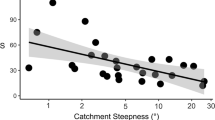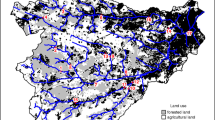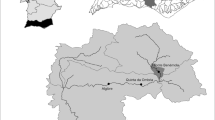Abstract
Environmental determinants of fluvial food-chain length (FCL) remain unresolved, with predominant hypotheses pointing to productivity, disturbance, and/or ecosystem size. However, drainage configuration (for example, drainage density, and stream length)—in spite of recent advances demonstrating the significance of catchment structure to habitat and biodiversity of fluvial systems—has yet to be explored in relation to FCL. In this study, we quantified the relative influences of ecosystem size and structure on FCL for linked stream–riparian food webs. At 19 stream reaches distributed within three mountain catchments of northern Idaho, USA, we sampled aquatic and riparian consumers and determined FCL using the naturally abundant stable isotopes 13C and 15N. Food-chain length was then related to reach measures of size and structure using an information-theoretic model selection approach. Model selection was followed by exploratory linear regression of FCL with purported mechanistic factors (that is, resource availability and disturbance regime). FCL ranged from 2.6 to 4.4 across study reaches and was best explained by catchment structure such as number of tributary junctions and distance to nearest downstream confluence. Regression analyses suggested that disturbance regime may mechanistically link number of tributary junctions and FCL, as well as drainage area and FCL. Our results introduce novel evidence that ecosystem structure may integrate the effects of several mechanistic factors and thus be an important predictor of food-web structure.







Similar content being viewed by others
References
Altermatt F. 2013. Diversity in riverine metacommunities: a network perspective. Aquat Ecol 47:365–77.
Altermatt F, Seymour M, Martinez N. 2013. River network properties shape alpha-diversity and community similarity patterns of aquatic insect communities across major drainage basins. J Biogeogr 40:2249–60.
Anderson C, Cabana G. 2007. Estimating the trophic position of aquatic consumers in river food webs using stable nitrogen isotopes. J N Am Benthol Soc 26:273–85.
Angermeier PL, Wheeler AP, Rosenberger AE. 2004. A conceptual framework for assessing impacts of roads on aquatic biota. Fisheries 29:19–29.
Baxter CV, Fausch KD, Saunders WC. 2005. Tangled webs: reciprocal flows of invertebrate prey link streams and riparian zones. Freshw Biol 50:201–20.
Bearhop S, Waldron S, Votier SC, Furness RW. 2002. Factors that influence assimilation rates and fractionation of nitrogen and carbon stable isotopes in avian blood and feathers. Physiol Biochem Zool 75:451–8.
Benda L, Poff LN, Miller D, Dunne T, Reeves G, Pess G, Pollock M. 2004. The network dynamics hypothesis: how channel networks structure riverine habitats. Bioscience 54:413–27.
Benda L, Veldhuisen C, Black J. 2003. Debris flows as agents of morphological heterogeneity at low-order confluences, Olympic Mountains, Washington. Geol Soc Am Bull 115:1110–21.
Bodin O, Norberg J. 2007. A network approach for analyzing spatially structured populations in fragmented landscape. Landsc Ecol 22:31–44.
Burnham KP, Anderson DR. 2002. Model selection and inference: a practical information-theoretic approach. New York: Springer-Verlag.
Burnham KP, Anderson DR. 2004. Multimodel inference—understanding AIC and BIC in model selection. Sociol Methods Res 33:261–304.
Carrara F, Altermatt F, Rodriguez-Iturbe I, Rinaldo A. 2012. Dendritic connectivity controls biodiversity patterns in experimental metacommunities. Proc Natl Acad Sci USA 109:5761–6.
Carrara F, Rinaldo A, Giometto A, Altermatt F. 2014. Complex interaction of dendritic connectivity and hierarchical patch size on biodiversity in river-like landscapes. Am Nat 183:13–25.
Caut S, Angulo E, Courchamp F. 2009. Variation in discrimination factors (Δ15N and Δ15C): the effect of diet isotopic values and applications for diet reconstruction. J Appl Ecol 46:443–53.
Chevan A, Sutherland M. 1991. Hierarchical partitioning. Am Stat 45:90–6.
Cianfrani CM, Hession WC, Watzin MC. 2004. Evaluating aquatic habitat quality using channel morphology and watershed-scale modeling techniques. World Water and Environmental Resources Congress. Reston: American Society of Civil Engineers.
Cohen JE, Newman CM. 1991. Community area and food-chain length—theoretical predictions. Am Nat 138:1542–54.
Collier KJ, Lill A. 2008. Spatial patterns in the composition of shallow-water macroinvertebrate communities of a large New Zealand river. N Z J Mar Freshw Res 42:129–41.
Grant EHC, Lowe WH, Fagan WF. 2007. Living in the branches: population dynamics and ecological processes in dendritic networks. Ecol Lett 10:165–75.
Guo Q, Kelt DA, Sun Z, Liu H, Hu L, Ren H, Wen J. 2013. Global variation in elevational diversity patterns. Sci Rep 3:3007.
Gurnell AM, Piegay H, Swanson FJ, Gregory SV. 2002. Large wood and fluvial processes. Freshw Biol 47:601–19.
Harrelson CC, Potyondy JP, Rawlins CL. 1994. Stream channel reference sites: an illustrated guide to field technique. General Technical Report RM-245. Fort Collins, CO: US Department of Agriculture, Forest Service, Rocky Mountain Forest and Range Experiment Station.
Hette-Tronquart N, Roussel JM, Dumont B, Archaimbault V, Pont D, Oberdorff T, Belliard J. 2013. Variability of water temperature may influence food-chain length in temperate streams. Hydrobiologia 718:159–72.
Hijmans RJ, Williams E, Vennes C. 2014. Geosphere: spherical trigonometry. R package version 1.3-11. http://cran.r-project.org/web/packages/geosphere/index.html.
Hobson KA, Clark RG. 1992. Assessing avian diets using stable isotopes I: turnover of 13C in tissues. Condor 94:181–8.
Hussey NE, MacNeil MA, McMeans BC, Olin JA, Dudley SFJ, Cliff G, Wintner SP, Fennessy ST, Fisk AT. 2014. Rescaling the trophic structure of marine food webs. Ecol Lett 17:250–93.
Hutchinson GE. 1959. Homage to Santa-Rosalia or why are there so many animals. Am Nat 93:145–59.
Jenkins B, Kitching RL, Pimm SL. 1992. Productivity, disturbance and food web structure at a local scale in experimental container habitats. Oikos 65:249–55.
Junk WJ, Bailey PB, Sparks RE. 1989. The flood pulse concept in river-floodplain systems. In: Dodge DP, Ed. International River Symposium. Ottawa: Canadian Special Publication of Fisheries and Aquatic Sciences. p 110–27.
Kiffney PM, Greene CM, Hall JE, Davies JR. 2006. Tributary streams create spatial discontinuities in habitat, biological productivity, and diversity in mainstem rivers. Can J Fish Aquat Sci 63:2518–30.
Kondolf GM, Micheli EM. 1995. Evaluating stream restoration projects. Environ Manag 19:1–15.
Krause AE, Frank KA, Mason DM, Ulanowicz RE, Taylor WW. 2003. Compartments revealed in food-web structure. Nature 426:282–5.
Lamberti GA, Steinman AD. 1997. A comparison of primary production in stream ecosystems. J N Am Benthol Soc 16:95–104.
Lancaster J, Waldron S. 2001. Stable isotope values of lotic invertebrates: Sources of variation, experimental design, and statistical interpretation. Limnol Oceanogr 46:723–30.
Loegering JP, Anthony RG. 1999. Distribution, abundance, and habitat association of riparian-obligate and -associated birds in the Oregon Coast Range. N W Sci 73:168–85.
Mac Nally R. 2000. Regression and model-building in conservation biology, biogeography and ecology: the distinction between—and reconciliation of—’predictive’ and ‘explanatory’ models. Biodivers Conserv 9:655–71.
Mazumder A. 1994. Patterns of algal biomass in dominant odd-link vs even-link lake ecosystems. Ecology 75:1141–9.
McHugh PA, McIntosh AR, Jellyman PG. 2010. Dual influences of ecosystem size and disturbance on food chain length in streams. Ecol Lett 13:881–90.
Merritt RW, Cummins KW. 1996. An introduction to the aquatic insects of North America. Dubuque: Kendall/Hunt Publishing.
Montgomery DR, Buffington JM, Smith RD, Schmidt KM, Pess G. 1995. Pool spacing in forest channels. Water Resour Res 31:1097–105.
Moran PAP. 1950. Notes on continuous stochastic phenomena. Biometrika 37:17–23.
Murray K, Conner MM. 2009. Methods to quantify variable importance: implications for the analysis of noisy ecological data. Ecology 90:348–55.
Newman MEJ. 2010. Networks: an introduction. New York: Oxford University Press.
Oksanen J, Blanchet FG, Klindt R, Legendre P, Minchin PR, O’Hara RB, Simpson GL, Solymos P, Stevens MHH, Wagner H. 2013. Vegan: community ecology package. R package version 2.0-10. http://cran.r-project.org/web/packages/vegan/index.html
Olea PP, Mateo-Tomás P, de Frutos Á. 2010. Estimating and modelling bias of the hierarchical partitioning public-domain software: implications in environmental management and conservation. PLoS One 5:e11698.
Osborne LL, Wiley MJ. 1992. Influence of tributary spatial position on the structure of warmwater fish communities. Can J Fish Aquat Sci 49:671–80.
Paradis E, Bolker B, Claude J, Cuong HS, Desper R, Durand B, Dutheil J, Gascuel O, Heibl C, Lawson D, Lefort V, Legendre P, Lemon J, Nylander J, Opgen-Rhein R, Popescu A-A, Schliep K, Strimmer K, de Vienne D. 2014. Ape: analyses of phylogenetics and evolution. R package version 3.1-4. http://cran.r-project.org/web/packages/ape/index.html.
Persson L, Diehl S, Johansson L, Andersson G, Hamrin SF. 1992. Trophic interactions in temperate lake ecosystems: a test of food chain theory. Am Nat 140:59–84.
Peterson EE, Merton AA, Theobald DM, Urquhart NS. 2006. Patterns of spatial autocorrelation in stream water chemistry. Environ Monit Assess 121:571–96.
Pimm SL. 1982. Food webs. London: Chapman and Hall.
Pimm SL, Lawton JH. 1977. Number of trophic levels in ecological communities. Nature 268:329–31.
Pinnegar J, Polunin N. 1999. Differential fractionation of δ13C and δ15N among fish tissues: implication for the study of trophic interactions. Funct Ecol 13:225–31.
Post D. 2002a. Using stable isotopes to estimate trophic position: Models, methods, and assumptions. Ecology 83:703–18.
Post DM. 2002b. The long and short of food-chain length. Trends Ecol Evol 17:269–77.
Post DM, Pace ML, Hairston NG. 2000. Ecosystem size determines food-chain length in lakes. Nature 405:1047–9.
Post DM, Takimoto G. 2007. Proximate structural mechanisms for variation in food-chain length. Oikos 116:775–82.
Power ME, Dietrich WE. 2002. Food webs in river networks. Ecol Res 17:451–71.
R Development Core Team. 2012. R: a language and environment for statistical computing. Vienna, Austria: R Foundation for Statistical Computing. www.r-project.org
Rahbek C. 1995. The elevational gradient of species richness: a uniform pattern? Ecography 18:200–5.
Sabo JL, Finlay JC, Kennedy T, Post DM. 2010. The role of discharge variation in scaling of drainage area and food chain length in rivers. Science 330:965–7.
Sabo JL, Finlay JC, Post DM. 2009. Food chains in freshwaters: Year in Ecology and Conservation Biology 2009. Oxford: Blackwell Publishing. pp 187–220.
Smith AC, Koper N, Francis CM, Fahrig L. 2009. Confronting collinearity: comparing methods for disentangling the effects of habitat loss and fragmentation. Landsc Ecol 24:1271–85.
Smith TA, Kraft CE. 2005. Stream fish assemblages in relation to landscape position and local habitat variables. Trans Am Fish Soc 134:430–40.
Steinman AD, Lamberti GA. 1996. Biomass and pigments of benthic algae. In: Hauer FR, Lamberti GA, Eds. Methods in stream ecology. San Diego: Academic Press. p 295–313.
Strahler AN. 1952. Hypsometric (area-altitude) analysis of erosional topography. Bull Geol Soc Am 63:1117–42.
Sullivan SMP. 2012. Geomorphic-ecological relationships highly variable between headwater and network mountain streams of northern Idaho, United States. J Am Water Resour Assoc 48:1221–32.
Sullivan SMP, Rodewald AD. 2012. In a state of flux: The energetic pathways that move contaminants from aquatic to terrestrial environments. Environ Toxicol Chem 31:1175–83.
Sullivan SMP, Vierling KT. 2009. Experimental and ecological implications of evening bird surveys in stream-riparian ecosystems. Environ Manag 44:789–99.
Sullivan SMP, Vierling KT. 2012. Exploring the influences of multiscale environmental factors on the American dipper Cinclus mexicanus. Ecography 35:624–36.
Swan CM, Brown BL. 2011. Advancing theory of community assembly in spatially structured environments: local vs regional processes in river networks. J N Am Benthol Soc 30:232–4.
Takimoto G, Post DM. 2013. Environmental determinants of food-chain length: a meta-analysis. Ecol Res 28:675–81.
Takimoto G, Post DM, Spiller DA, Holt RD. 2012. Effects of productivity, disturbance, and ecosystem size on food-chain length: insights from a metacommunity model of intraguild predation. Ecol Res 27:481–93.
Thompson RM, Townsend CR. 2005. Energy availability, spatial heterogeneity and ecosystem size predict food-web structure in streams. Oikos 108:137–48.
Thorp JH. 2014. Metamorphosis in river ecology: from reaches to macrosystems. Freshw Biol 59:200–10.
Triplehorn CA, Johnson NF. 2005. Borror and Delong’s introduction to the study of insects. 7th edn. Belmont: Thompson/Brooks/Cole Publishing.
United States Geological Survey (USGS). 2012. The StreamStats program for Idaho. http://water.usgs.gov/osw/streamstats/idaho.html.
Vanderklift MA, Ponsard S. 2003. Sources of variation in consumer-diet δ15N enrichment: a meta-analysis. Oecologia 136:169–82.
Vander Zanden M, Rasmussen J. 1999. Primary consumer δ13C and δ15N and the trophic position of aquatic consumers. Ecology 80:1395–404.
Vander Zanden MJ, Fetzer WW. 2007. Global patterns of aquatic food chain length. Oikos 116:1378–88.
Vander Zanden MJ, Shuter BJ, Lester N, Rasmussen JB. 1999. Patterns of food chain length in lakes: A stable isotope study. Am Nat 154:406–16.
Vannote RL, Minshall GW, Cummins KW, Sedell JR, Cushing CE. 1980. The river continuum concept. Can J Fish Aquat Sci 37:130–7.
Vincenty T. 1975. Direct and inverse solutions of geodesics on the ellipsoid with application of nested equations. Survey Rev 23:88–93.
VTDEC. 2003. Stream geomorphic assessment handbook: rapid stream assessment—phase 2 field protocols. Waterbury, VT: Vermont Agency of Natural Resources, Department of Environmental Conservation, Water Quality Division.
Walsh C, Mac Nally R. 2013. Hier.part: hierarchical partitioning. R package version 1.0-4. http://cran.r-project.org/web/packages/hier.part/index.html.
Warfe DM, Jardine TD, Pettit NE, Hamilton SK, Pusey BJ, Bunn SE, Davies PM, Douglas MM. 2013. Productivity, disturbance and ecosystem size have no influence on food chain length in seasonally connected rivers. PLoS ONE 8:e66240.
Wheeler AP, Angermeier PL, Rosenberger AE. 2005. Impacts of new highways and subsequent landscape urbanization on stream habitat and biota. Rev Fish Sci 13:141–64.
Wiggins GB. 2004. Caddisflies: the underwater architects. Toronto: University of Toronto Press.
Wohl E, Merritt DM. 2008. Reach-scale channel geometry of mountain streams. Geomorphology 93:168–85.
Acknowledgements
We thank Dr. Jeff Braatne; Potlatch Corporation; and the Department of Fish and Wildlife Resources, University of Idaho for support during the initial stages of the project. Funding to SMPS was provided by the National Research Initiative of the US Department of Agriculture Cooperative State Research, Education, and Extension Service, grant number 2003-01264; the Mountaineers Foundation; the University of Idaho, College of Natural Resources; and The Ohio State University, School of Environment and Natural Resources. We thank all coworkers who assisted in field and laboratory work, especially Adam Kautza, Ryan Mann, Danielle Vent, Jeremy Alberts, Paul Charpentier, and Matthew Mason. We also thank the anonymous reviewers whose comments and suggestions improved this manuscript.
Author information
Authors and Affiliations
Corresponding author
Additional information
Author contributions
SMP Sullivan conceived and designed the study. SMP Sullivan collected the data with contributions from CM Cianfrani. K Hossler analyzed the data with contributions from SMP Sullivan. All authors contributed to preparation of the manuscript.
Electronic supplementary material
Below is the link to the electronic supplementary material.
Rights and permissions
About this article
Cite this article
Sullivan, S.M.P., Hossler, K. & Cianfrani, C.M. Ecosystem Structure Emerges as a Strong Determinant of Food-Chain Length in Linked Stream–Riparian Ecosystems. Ecosystems 18, 1356–1372 (2015). https://doi.org/10.1007/s10021-015-9904-7
Received:
Accepted:
Published:
Issue Date:
DOI: https://doi.org/10.1007/s10021-015-9904-7




